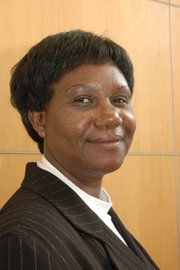BOWIE, Md. — Two Bowie State University professors awarded NASA fellowships in the emerging field of astrobiology will continue their research with students in the fall– their discoveries could have major implications on future biomedical innovations and the search for life outside of Earth.
Bowie State University
Dr. Anne Osano
Drs. Alan Anderson and Anne Osano were among five fellows paired with some of the nation’s leading scientists for 10 weeks this summer, as part of the NASA Astrobiology Institute Minority Institution Research Support Program. The goal is to engage faculty from underrepresented colleges in astrobiology research and encourage more minority students to pursue astrobiology careers. Both professors will equip their Bowie State laboratories with specialized equipment to recreate their experiments, with the help of a $10,000 award from the program.
Anderson worked with chemist Ramanarayanan Krishnamurthy from the Scripps Research Institute in La Jolla, Calif. to synthesize DNA and proteins and uncover answers about how to replicate biological material in a lab. Findings from his research could ultimately impact how doctors treat patients with conditions, such as a heart arrhythmia. By replacing dysfunctional cells with new synthetic DNA strands that behave properly, the result might cause regular heartbeats in heart arrhythmia patients.
An organic chemist, Anderson learned advanced research techniques that he will now introduce to his students. “We can not only discuss DNA in the classroom, but now we can actually synthesize a DNA double helix in my laboratory at Bowie State University,” he said.
Osano’s research focused on answering the question of whether life forms can exist outside of Earth. She collaborated with scientist Alfonso Davila from the SETI Institute in Mountain View, Calif. to investigate one of the planet’s oldest life forms.
Cyanobacteria are believed to be responsible for converting primitive Earth from an environment devoid of oxygen into one that can sustain life around 2.4 billion years ago. Using samples from the one of the driest places on Earth – the Atacama Desert in Chile – the two determined that cyanobacteria can indeed perform photosynthesis even in extremely dry climates. Osano’s findings will shed light on questions crucial to the study of life in desert planets like Mars.
By continuing her research in the upcoming academic year, Osano will expose her students to the cutting-edge methodologies she learned this summer to better understand how cyanobacteria function.
“Involving students in the research will create an awareness of the possibilities and opportunities in astrobiology,” Osano said. “Since I cannot bring the students here to NASA, I am bringing back the same project that I’ve been doing here, so I can involve a lot more students.”

